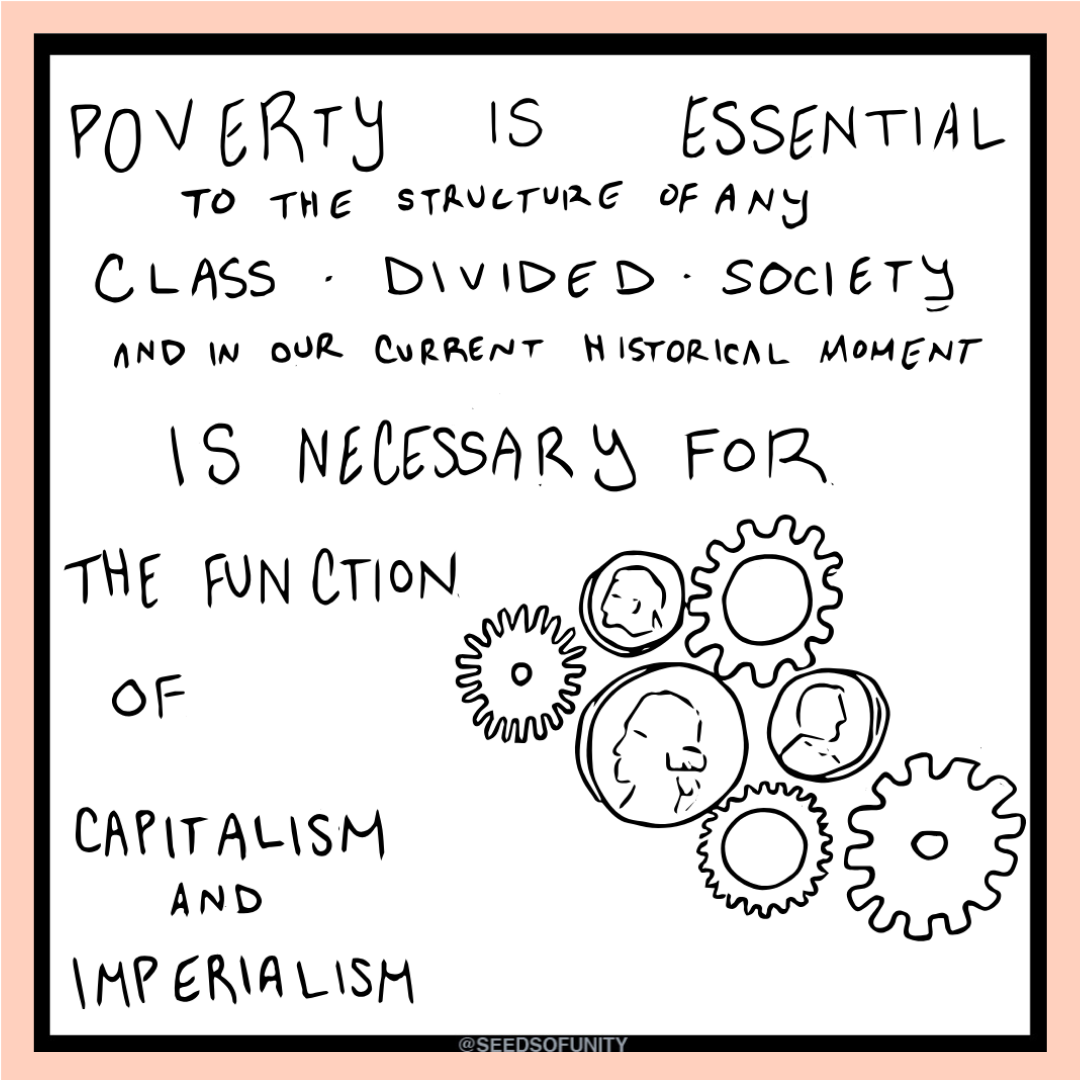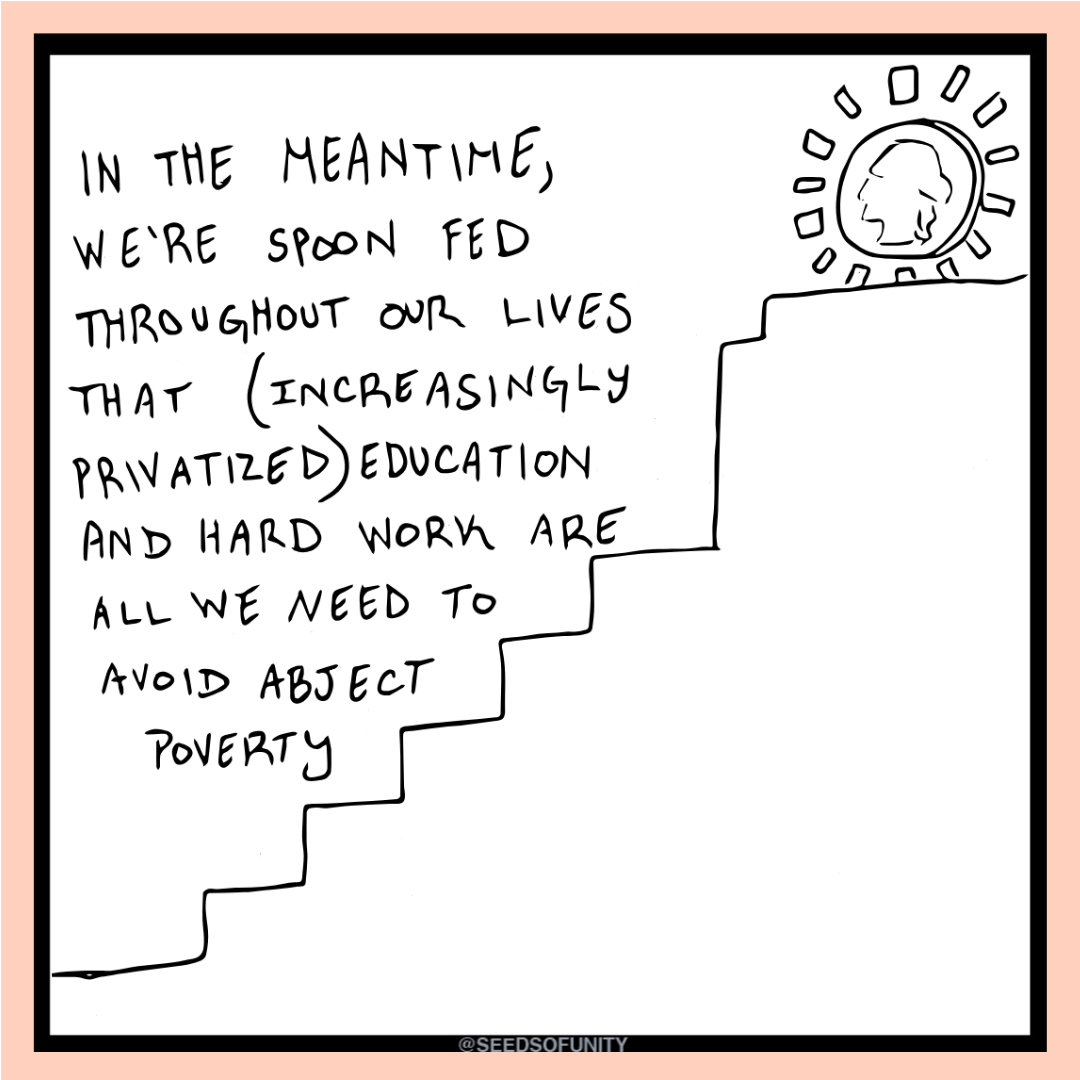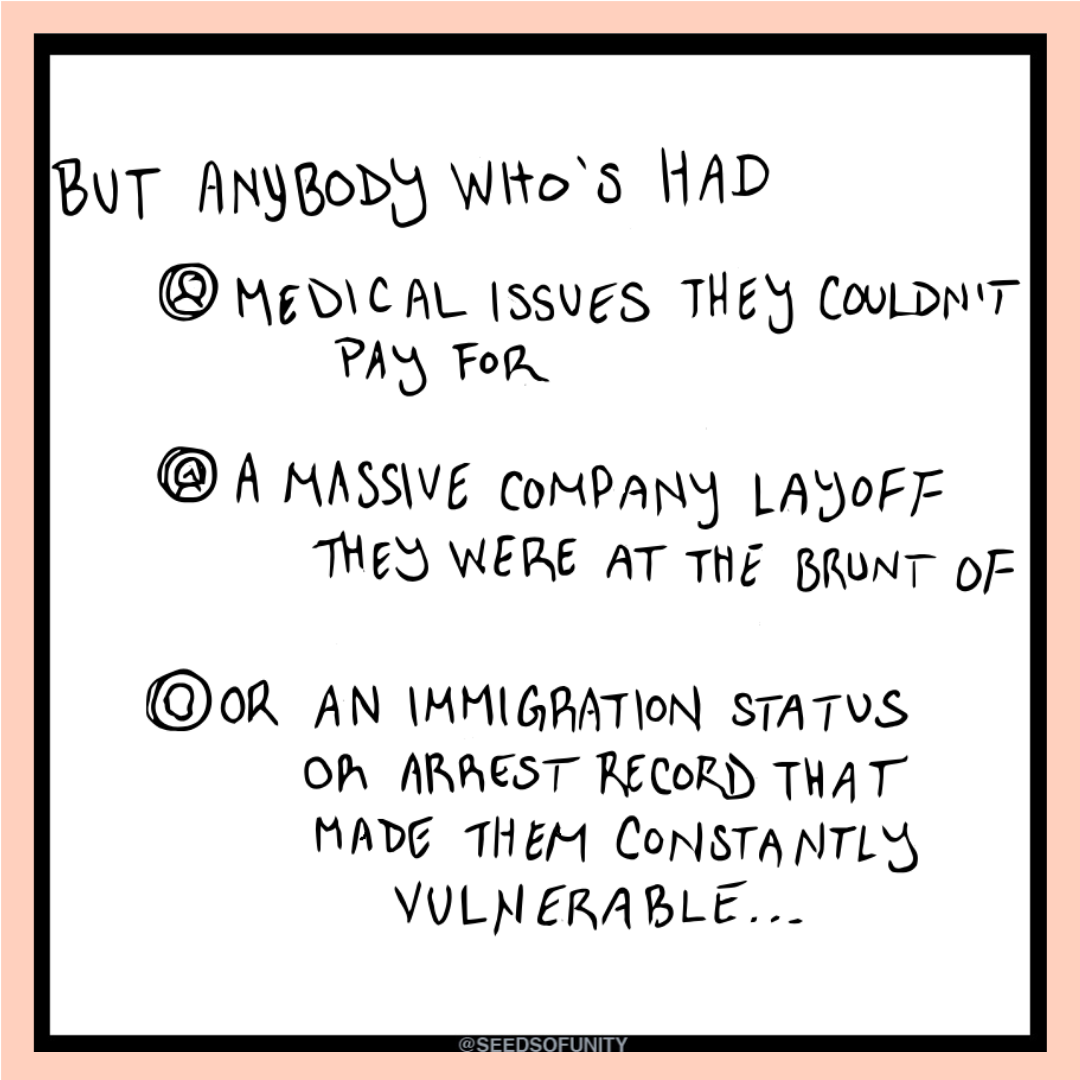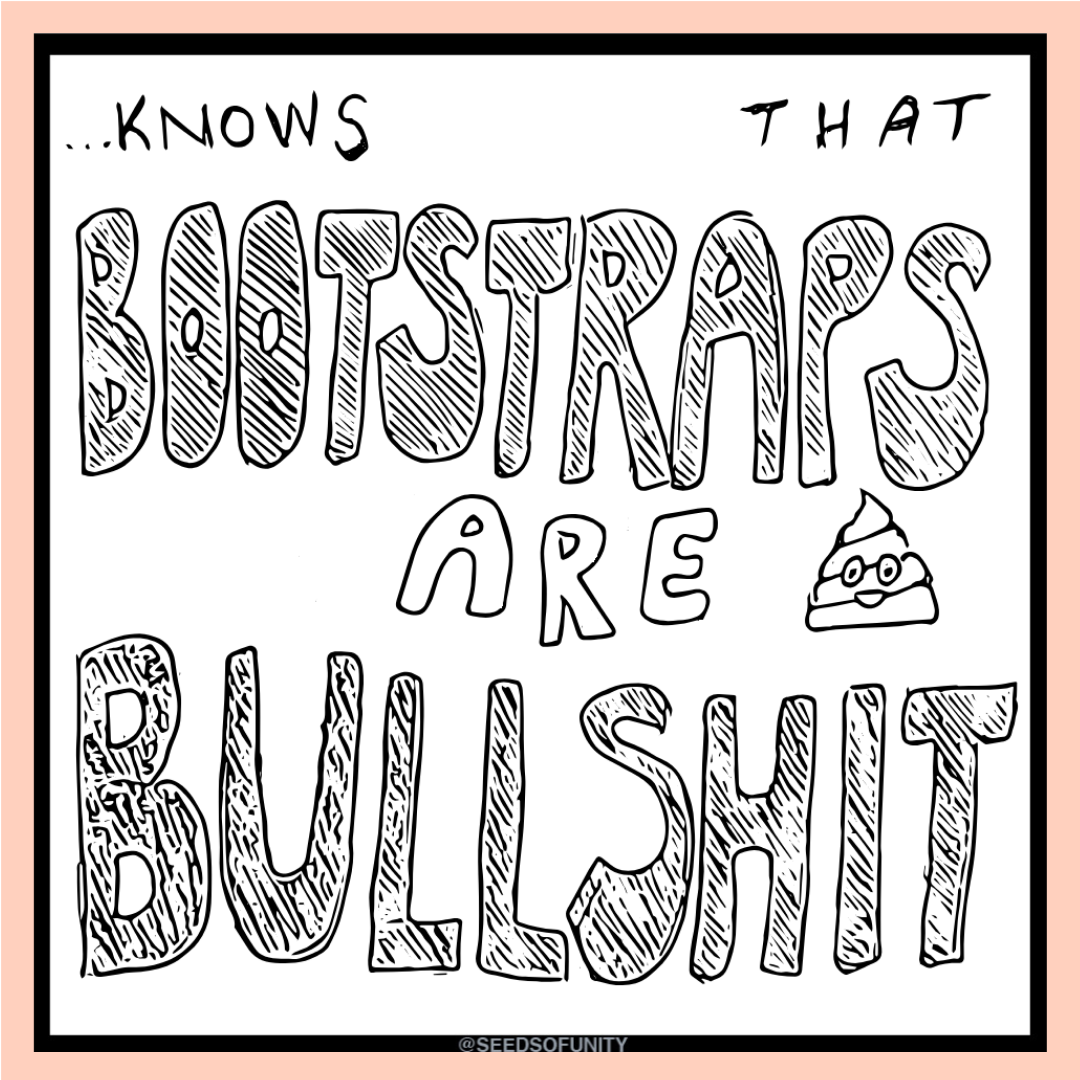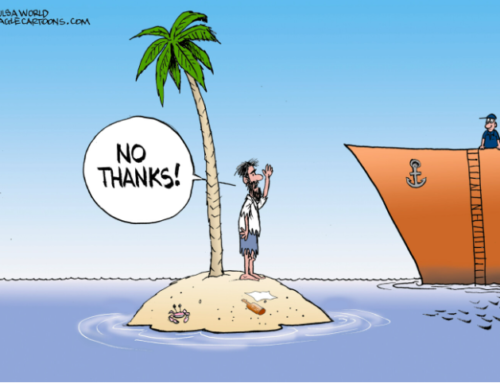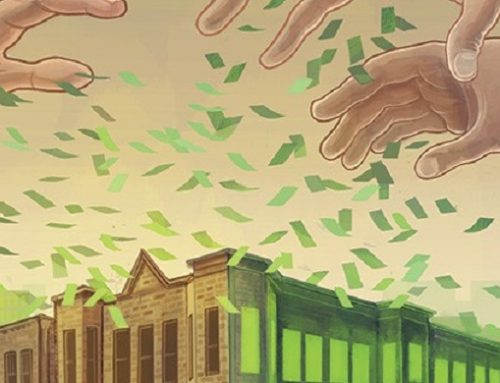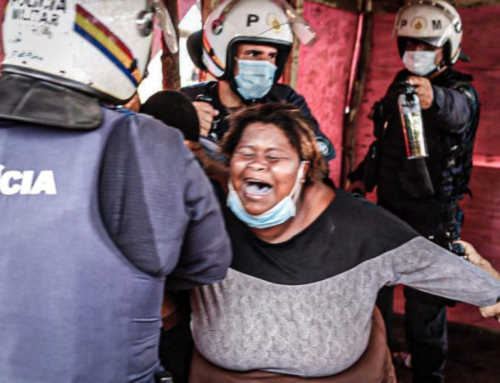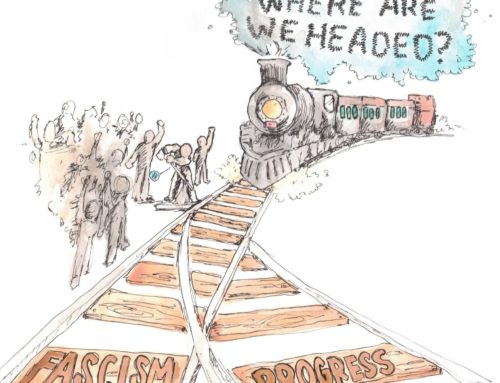Poverty is not an accident. It isn’t “natural” or “relative,” and it doesn’t stem from stupidity, mismanagement, or corruption. Poverty is essential to the structure of any class-divided society and, in our current historical moment, is necessary for the function of capitalism and imperialism.
Poverty is perpetrated by the ruling class and perpetuated with racism, sexism, ideological manipulation, and inequality within education. It serves to solidify the power of capitalists through economic submission and is used as a fundamental weapon to legitimize wealth and benefits. Beyond income, it divides the masses politically and ideologically in order to stifle attempts for progressive change while helping to galvanize the masses to work in the interests of the capitalist class.
Historical Developments in Poverty
Everything in our present and in our history is and has functioned to normalize the accumulation of wealth. To understand poverty and inequality, we must understand how concepts like private property and ownership have developed out of constant class struggle.
Our understanding of history has largely been defined by the ruling classes’ struggle for riches, from the old empires of Roman imperialism to the conquest and looting of the Americas at the beginning of capitalism to the industrial revolution…and so on. In all class divided societies – not just capitalist ones – history has been written by the ruling classes, from the moment they became capable of accumulation.
In the dying throes of feudalism, peasants had gained more rights than ever before as a direct result of class struggle. The ruling classes scrambled to develop new means of accumulation in the wake of this, and abject poverty was exacerbated as a result of the transition from feudalism to capitalism. Under lords, people had their own land and would work the lord’s land a certain amount to “earn” the right to exist under his dominion, thus having access to the protection of a standing army and the like. With the advent of rent, people were dispossessed from their lands and required to engage in wage-labor to sustain their livelihood.
From this point on, workers owned only what they could make from their labor; if they were barred from wage labor (as in the case of some women, the disabled, slaves and indentured servants, etc) they were condemned to a new sort of impoverished state. As more and more peasants were thrown from their land for the inability to pay, they moved into the cities to become industrial laborers to drive the industrial revolution. This would establish the role of poverty under capitalism for generations to come – a desperate state that drives laborers to create value for the capitalist class, no matter the conditions or the danger of the work. Their only means of survival is exploitation – otherwise, they’re forced to live in degenerate conditions as outcasts of society.
This arrangement requires a constantly refreshing pool of impoverished laborers – if it was merely a matter of getting everybody on board with capitalism, we would have seen history repeat itself. Like the peasants under feudalism, workers would rise up and demand more and more of the fruits of their labors until exploitation became impossible. Ideological domination became necessary to divide those dominated by the capitalist class so that accumulation could stay concentrated at the very top.
Thus we can see the seeds of racism, sexism, xenophobia, and other oppressive ideologies begin to morph for the benefit of colonizers, land owners, and all other fractions of the bourgeoisie. In the Americas in particular, we saw Bacon’s rebellion instigate the racial divisions that “justified” the Southern economy’s shift from indentured servitude to African slavery; the witch trials of the 18th century limited women’s access to labor and later resulted in their special exploitation under industrialization; and meanwhile, to all of these populations, Native Americans were demonized to justify huge land acquisitions. And while striations of “privilege” may have existed because of these divisions, the objective was simple: when the small landowner feared the conditions of the indentured servant and the indentured servant feared the conditions of the slave, none of these fractions of the masses would recognize their true enemy – the capitalist class.
Imperialism, Poverty, and the Petite Bourgeoisie
Peasants’ struggle for equality was essential to the eventual fall of feudalism, and workers’ struggles throughout history and today will be essential to the fall of capitalism. Even with the ideological domination of racism, sexism, and xenophobia, the struggles of workers have won us essential rights in opposition to the outright exploitation required by the ruling classes. Positive reforms to capitalism have objectively lead to an improvement in quality of life, particularly in nations like the U.S. More of us have shelter, clothing, and a lengthened life expectancy compared to the broad conditions of humanity at the end of feudal dominance.
But we can’t afford to confuse the progression of human technology with the misconception that innovation and efficiency are somehow inherent to capitalism. In reality, innovations that improve quality of life are often hoarded by the bourgeoisie until they become obsolete, or capable of providing new means of accumulation. This is why we see cures that cost exorbitant amounts of money or new forms of automation threatening to decimate peoples’ livelihoods – innovation always serves the international capitalist class.
To the extent that the masses do benefit from these advancements, it’s never as a form of altruism. Early on in capitalism’s development, ruling classes realized the need for a buffer class to insulate themselves from the desperate fractions of the masses. This is the petite bourgeoisie (PB) – the majority of us in imperialist countries who can afford to eat at restaurants where we update our Instagram feeds with pictures of out-of-season and exotic foods flown in from dominated countries. On the one hand, the PB aspires to accumulate and reproduce like the capitalist class (being dual consumers and debtors to benefit the bourgeoisie) while simultaneously clambering to justify the conditions of workers who grow their food, sew their clothes, and build their electronics.
It is this simultaneous domination and benefit that ties the existence of the PB to both the working class and poverty. This has only worsened as imperialism drags the wages and conditions of international workers (not to mention the planet) further and further into devastation. World War 1 and World War 2 solidified the United States as an imperialist power capable of profiting not only from militaristic efforts themselves, but also the resources of nations it could subjugate. As offshoring labor to these subjugated countries ramped up starting in the 1960s, the U.S. and other imperialist powers began the path to the arrangement we’re immersed in today – one in which our “working class hero” is a millionaire at the same time as hundreds die from poor infrastructure and recovery after a natural disaster abroad.
Poverty in the United States Today
Over four hundred years after the first settlement of what would become the United States, the same ideological divisions exist and poverty is still a state that drives laborers at different levels of economic prosperity toward the acceptance – and even the celebration! – of capitalist domination. Imperialism now sends the bulk of working class exploitation overseas where we can ignore it while staring down our noses at “developing” countries (read: countries dominated by imperialist powers like the U.S.). In the meantime, we’re spoon fed as children and beyond that (increasingly privatized) education and hard work are all we need to avoid abject poverty.
But anybody who’s had medical issues they couldn’t pay for (despite having insurance), a learning disability they couldn’t get support for (despite sympathetic teachers or parents), a massive company lay-off they were at the brunt of (while the CEO walked away with a massive bonus), or an immigration status or arrest record that made them constantly vulnerable (despite working harder than most)…knows that bootstraps are bullshit.
The United States has experienced an increase in economic inequality in the past decades. As one of the wealthiest nations in the world, its gross domestic product (GDP) was over $19 trillion at the end of 2017; GDP per capita was close to $60,000, well above most other countries. But these numbers are basically meaningless to the average person living in the U.S., worrying about how to put food on the table or keep their lights on. There are 39.7 million people living in poverty while the richest 1% owns more of the country’s wealth than at any time in the past 50 years. Twenty one percent of all children live in families with income below the federal poverty line. Net productivity has grown 77% while the average wage has only grown 12%.This means that although Americans are working more productively than ever, the fruits of their labors have primarily gone to those at the top and to corporate profits, especially in recent years. CEOs make 271 times the pay of the average laborer, up from the 59-1 ratio in 1989, and vastly beyond the 20-1 ratio of 1965.
Because of these massive changes for the wealthy, the factors that make life precarious for average Americans haven’t changed fundamentally at all. The list is long, but it would include:
– $1.5 trillion in student debt
– 80 percent of American laborers living paycheck to paycheck
– lost wealth from the 2008 housing crash
– unaffordable childcare costs
– a retirement savings crisis
– The Labor Department reported that increases in costs of living superseded wage increases from 2017 to 2018.
Political maneuvers, sold as attempts to alleviate these issues, have merely accelerated the established trend. Trump’s 2018 tax cuts stimulated the economy, as most economists predicted, but their impact was highly concentrated in the corporate sector and among the very rich. Companies buy their own stock, increasing its price and putting money into their shareholders’ pockets, rather than investing it into the community. Shareholders saw a $1 trillion windfall from stock buybacks.
But this reality isn’t unprecedented. As we’ve seen in history and as we’ll see in any capitalist/imperialist future, we have been and always will be sold out for the reproduction of the bourgeoisie. Poverty is the constant threat all dominated and exploited people face that keeps us chasing the carrot of accumulation and comfort. We separate ourselves further and further into tiny dynasties of wealth in fear of becoming like the welfare parent, the factory worker, or the diner server. But in reality, we’re still being duped by those who would easily take away our homes, our livelihoods, our rights, and our planet in order to ensure the constant growth of their economy.
The longer we believe that poverty or any of the conditions under a class divided society are “natural” and not the direct result of oppression and subjugation, the longer we’ll be left to repeat history. A truly progressive politics doesn’t try to get more people a bigger piece of a pie that’s baked out of exploitation and domination – it weakens the conditions that creates that prosperity only ever meant for a few people at the top. If we really want to see the end of poverty, we must fight the arrangement that necessitates it: capitalism and imperialism.
Get it touch if you agree or want to discuss more.
onestruggle.southflorida@gmail.com
onestruggle.fiu@gmail.com
FB – @OneStruggle
IG – @SeedsofUnity // @OneStruggle.FIU
Twitter – @OneStruggleSF

